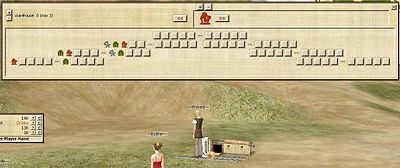The Wiki for Tale 4 is in read-only mode and is available for archival and reference purposes only. Please visit the current Tale 11 Wiki in the meantime.
If you have any issues with this Wiki, please post in #wiki-editing on Discord or contact Brad in-game.
Principles of Thought
Principles of Thought
Build an Empty Hand Puzzle and have 7 people solve and rate it.
- Dry Flax
- Gather Clay
- Make Rope
- Dig Limestone
- Crush Cabbage for Juice
- Grate Carrots for Juice
- Build an Empty Hand Puzzle
- Design an Empty Hand Puzzle and Solve it
- Have 7 Judges solve and rate your Empty Hand Puzzle
- Claim your rights as Initiate of Thought
- All of the above, OR solve three recently recognized Empty Hand
Once you pass the principle, you will gain a level and will also be able to sign up for the seven Tests of the Thought discipline (provided that you meet the level requirements).
Level Required: 3
Demonstrate the Principle
What it will take to unlock the test for Egypt.
- 1000 Dried Flax
- 1200 Thorns
- 500 Boards
- 300 Rope
- 900 Cabbage Juice
- 900 Red Sand
- 900 Carrot Juice
- 900 Clay
- 900 Limestone
- 900 Grass
Demonstrated by NatuBo in Shabbat Ab on 2008-12-17.
Building
Empty Hand Puzzle
- 20 Dried Flax for stuffing Blocks
- 25 Thorns for Block Separators
- 80 Clay for Base
- 50 Boards for Holding Area
- 60 Limestone for extra Block weight
- 30 Rope for Mechanism
Built in a Small Construction Site (4 Rope, 1 Canvas).
- note***
you will also need to add atleast three blocks to the puzzle to make it work. to do this see material requirements below. --wopper87 23:01, 17 December 2008 (EST)
Each Block Added
- 7 Cabbage Juice (for Coloring Purple Face)
- 7 Dirt (for Coloring Red Face) *Changed from the much more rare Red Sand*
- 7 Limestone (for Coloring Light Face)
- 7 Clay (for Coloring Brown Face)
- 7 Carrot Juice (for Coloring Orange Face)
- 7 Grass (for Coloring Green Face)
- 1 Canvas (for Cushioning)
Designing
You have severl areas to map. at the top left is your warehouse. this will hold extra blocks that could be used later in play. The top middle is your starting block(s). The open middle playfield is what transitions are allowed. Each section (boxes)>>(boxes) is a seperate transition. The block color coding on the left can be turned into the color coding on the right.
Playing
The goal of playing an Empty Hand puzzle is to...well, empty your hand by removing all of the blocks. The game is composed of a system of rules which allow changing a particular pattern of blocks into other patterns of blocks. The ultimate goal is to play a rule that turns all of the blocks into 'nothing' by creating the pattern that allows the rule to be used.
For example, if the blocks are Red, Green, Blue and there is a rule to turn Green, Green, Blue into nothing, you would want to first play a rule that changes Red, Green into Green, Green. This would then create the appropriate condition to play the other rule, allowing you to win the puzzle.
This all becomes much more clear when you watch the animation of what's actually happening on the puzzle machine when you play the rules.
